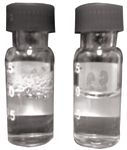Effective Cleanup and Analysis of Metronidazole from Foaming Facial Cleanser
The Application Notebook
When working with complex matrices such as personal care products, sample preparation is perhaps the most difficult step of the analysis process. By utilizing a targeted sample preparation technique, such as ion-exchange SPE, analysis can be significantly improved as compared to less targeted techniques such as liquid-liquid extraction.
When working with complex matrices such as personal care products, sample preparation is perhaps the most difficult step of the analysis process. By utilizing a targeted sample preparation technique, such as ion-exchange SPE, analysis can be significantly improved as compared to less targeted techniques such as liquid-liquid extraction. Our work successfully extracted metronidazole from foaming facial cleanser using a polymeric cation-exchange SPE sorbent, Strata™ -X-C, followed by a rapid LC–MS-MS analysis on a Kinetex® 2.6 µm XB-C18 HPLC/UHPLC core-shell column.
Materials & Methods
Sample Pretreatment:
1. Dissolve 0.250 g of Foaming Facial Cleanser in 10 mL of 0.1 N HCl
2. Vortex until homogeneous
3. Centrifuge sample at 5000g for 5 min
Solid Phase Extraction
The pretreated sample is further cleaned up and concentrated using SPE.
Cartridge: Strata-X-C, 30 mg/3 mL
Part No.: 8B-S029-TBJ
Condition: 1 mL methanol
Equilibrate: 1 mL 0.1 N HCl
Load: 3 mL of pretreated sample
Wash 1: 3 mL 0.1 N HCl
Wash 2: 3 mL methanol
Wash 3: 6 mL ethyl acetate
Dry: 5 min under full vacuum
Elute: 1 mL 5% NH4OH in methanol (v/v)
Dry down: Evaporate under a stream of nitrogen gas at 50 °C until dry
Reconstitute: Reconstitute samples with 200 µL of methanol/0.1% formic acid (10:90)
Results and Discussion
We were able to effectively extract metronidazole from foaming facial cleanser using a targeted SPE procedure on Strata-X-C polymeric SPE sorbent. The cation-exchange properties of the Strata-X-C SPE sorbent targeted the sp2 hybridized nitrogen at the 3 position of the imidazole ring in the metronidazole structure, forming a tight bond between the sorbent and the metronidazole compound. The strong interaction allowed a strong solvent wash of ethyl acetate to be performed which removed a significant amount of matrix interferences (Figure 1).

Figure 1: The vial on the left was not subjected to a strong organic wash and therefore contains matrix interferences such as foaming agents. After a strong ethyl acetate wash, matrix interferences are no longer present in the vial on the right.
Conclusion
By implementing a targeted SPE method, matrix interferences were significantly removed from a foaming facial cleanser matrix. This cleanup process allowed for a sensitive LC–MS-MS method that could detect metronidazole at low levels, down to 100 pg/mL. (Visit www.phenomenex.com/Application and search for Application No. 20631 for LC–MS-MS conditions).
Phenomenex Inc.
411 Madrid Avenue, Torrance, CA 90501
Tel. (310) 212-0555, (310) 328-7768
Website: www.phenomenex.com

The Benefits of Custom Bonded Silica
April 1st 2025Not all chromatography resins are created equal. Off-the-shelf chromatography resins might not always meet the rigorous purification requirements of biopharmaceutical manufacturing. Custom bonded silica from Grace can address a wide range of separation challenges, leading to real performance improvements. Discover more about the latest innovations in chromatography silica from Grace, including VYDAC® and DAVISIL®.
5 Things to Consider When Selecting a Chromatography Silica
April 1st 2025Particularly in the pharmaceutical industry, drug purity isn’t just a goal – it’s essential for achieving safety, stability and efficacy. However, purification is easier said than done, especially with challenging molecules like DNA and RNA “oligonucleotides,” due in large part to their diversity and the range of impurities that can be generated during production. Enter DAVISIL® chromatographic silica, with a wide range of pore diameters and particle sizes to meet your specific application, performance and sustainability requirements. Before you choose the chromatography resin for your next purification application, take a look at these 5 considerations.
Automating Protein Purification: Efficiency, Yield, and Reproducibility
March 27th 2025Recent advancements in automated protein purification stress the importance of efficiency, scalability, and yield consistency. This eBook compares different purification platforms, highlighting their impact on downstream applications and demonstrating how automation enhances throughput and process control.
MilliporeSigma: Ultrapure Water for Sensitive LC-MS Analysis of Pesticides
March 25th 2025The aim of the study was to illustrate the efficiency of Milli-Q® water purification systems in eliminating pesticides from tap water, thereby producing and delivering reliable and consistent-quality ultrapure water suitable for pesticides analysis















